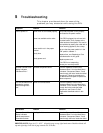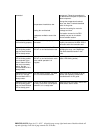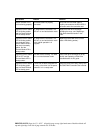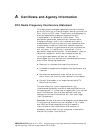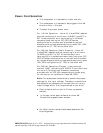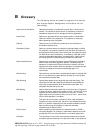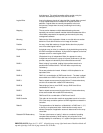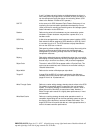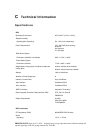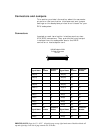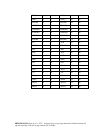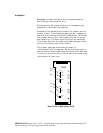
PRINTER NOTE: Page size 9” x 9.25”. Align this page to top, right hand corner. Back box bleeds off
top and right edge. Left side of page extends to 9.25 inches.
B Glossary
The following terms are used throughout this manual
and may be helpful background information on the
technology.
Asynchronous Operations Operations that bear no relationship to each other in time and can
overlap. The concept of asynchronous I/O operations is central to
independent access arrays in throughput-intensive applications.
Cache Flush Refers to an operation where all un-written blocks in a Write-Back
Cache are written to the target disk. This operation is necessary
before powering down the system.
Channel Refers to one of the SCSI bus connectors on the controllers or
termination interface cards.
Consistency Check Refers to a process where the integrity of redundant data is verified.
For example, a consistency check of a mirrored drive will make sure
that the data on both drives of the mirrored pair are exactly the same.
For RAID level 3 and 5 redundancy, a consistency check will involve
reading all associated data blocks, computing parity, reading parity,
and verifying that the computed parity matches the read parity.
Disconnect/Reconnect Disconnect is a function that allows a target SCSI device (typically a
disk drive that received a request to perform a relatively long I/O
operation) to release the SCSI bus so that the controller can send
commands to other devices. When the operation is complete and the
SCSI bus is needed by the disconnected target again, it is
reconnected.
Disk Mirroring Data written to one disk drive is simultaneously written to another disk
drive. If one disk fails, the other disk can be used to run the system
and reconstruct the failed disk.
Disk Spanning Several disks appear as one large disk using this technology. This
virtual disk can then store data across disks with ease without the
user being concerned about which disk contains what data. The
subsystem handles this for the user.
Disk Striping Data is written across disks rather than on the same drive. Segment 1
is written to drive 0, segment 2 is written to drive 1, and so forth until a
segment has been written to the last drive in the chain. The next
logical segment is then written to drive 0, then to drive 1, and so forth
until the write operation is complete.
Duplexing This refers to the use of two controllers to drive a disk subsystem.
Should one of the controllers fail, the other is still available to provide
disk I/O. In addition, depending how the controller software is written,
both controllers may work together to read and write data
simultaneously to different drives.
Fault-Tolerant When something is fault-tolerant it is resistant to failure. A RAID 1
mirrored subsystem, for example, is fault-tolerant because it can still
provide disk I/O if one of the disk drives in a mirrored system fails.
Hot Spare The “Hot Spare” is one of the most important features the controller
provides to achieve automatic, non-stop service with a high degree of



